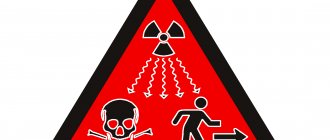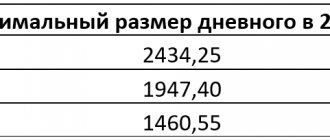Legislative framework and regulation
Initially, occupational hazards were outlined in the Resolution of the USSR Cabinet of Ministers, dated January 26, 1991. It received a second edition on October 2 of the same year. The document approves lists of people entitled to early retirement pension. The procedure for its approval is defined in Art. 30 of the Federal Law “On Labor Pensions” of 2013 and Resolution No. 665 of the Government of the Russian Federation.
Lists of professions with harmful factors
The class of hazardous working conditions is also regulated by other documents:
- Labor Code;
- Resolution No. 198P/122;
- Law No. 426 “On special assessment of working conditions”;
- Resolution No. 188.
The classification of working conditions allows us to determine how production factors affect a person.
Classification and list of professions with hazardous working conditions
A number of documents have been adopted, which indicate a list of hazardous professions, a list of hazardous work and the benefits provided. First of all, this is the Resolution of the State Committee of Labor of the USSR, the Presidium of the All-Union Central Council of Trade Unions of October 25, 1974 No. 298/P-22, which has not lost its relevance. This document contains a list of jobs with hazardous working conditions, a list of positions with hazardous working conditions and information on benefits is attached. Attached to this document are Instructions for the use of this list, which was approved by Resolution of the USSR State Committee for Labor, the Presidium of the All-Union Central Council of Trade Unions dated November 21, 1975 No. 273/P-20.
- First degree. At this degree of harm, changes in the human body are reversible, but there is a risk of acquiring an occupational disease;
- Second degree. The changes occurring in the body are persistent, the frequency of loss of working capacity (sick leave) increases, and occupational diseases begin to develop;
- Third degree. At this degree of hazard, mild occupational diseases occur;
- Fourth degree. Under these conditions, occupational diseases are pronounced, with prolonged loss of performance.
We recommend reading: Registration of a house in DNT
Classification of working conditions
Depending on the factors that a person faces, all working conditions are divided into four categories:
- optimal, when the microclimate is positive, labor productivity does not interfere with anything (manager, accountant);
- acceptable, in which the influence of harmful labor factors does not exceed the norm;
- harmful, when production issues can worsen human health;
- dangerous, associated with an increased risk of threat to life and injury.
Order No. 695 on psychiatric examination: list of professions
Particular attention is paid to harmful and dangerous working conditions. Those categories of exposures that affect reproductive function, reduce immunity and negatively affect a person’s psychological state are considered harmful.
For your information! Hazardous factors can directly provoke a sharp deterioration in health, resulting in the death of an employee. Most often this happens due to a violation of safety regulations at work.
The last two categories of working conditions can have varying degrees of influence:
- mild degree. When the influence of harmful factors ceases, the level of health is restored;
- the worker often goes on sick leave, chronic diseases are discovered;
- the health impairment is irreversible;
- persistent deterioration in the functioning of internal organs leads to disability and loss of the ability to work.
The degree of threat to the health and life of an employee depends on whether he uses protective equipment, takes regulated breaks, and takes measures to improve his health after a shift and prevent occupational diseases.
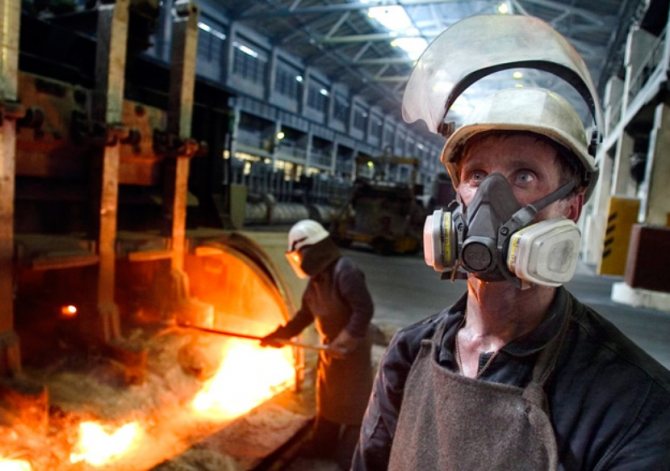
Worker in hazardous industry
There are certain harmful working conditions that lead to deterioration of health. Harmful working conditions, the list of professions for 2021, related to list Nos. 1 and 2, were compiled taking into account the effect of hazardous production factors on the worker.
List of hazardous working conditions in medicine
Workers engaged in heavy work and work with harmful and (or) dangerous working conditions are required to undergo preliminary and periodic medical examinations (Part 1 of Article 213 of the Labor Code of the Russian Federation). The procedure for their implementation was approved by Order of the Ministry of Health and Social Development of Russia dated April 12, 2011 No. 302n “On approval of lists of harmful and (or) hazardous production factors... (hereinafter referred to as the Procedure)”, which came into force on January 1, 2012.
The Ministry of Labor also examined the situation where, according to the results of an official assessment, a significant improvement in working conditions was noted. That is, instead of being “dangerous” or “harmful,” they are recognized as acceptable. In this case, it is proposed to direct the previous bonuses for harmfulness “to maintain the level of wages. taking into account the fulfillment of performance indicators.”
By what criteria are professions included?
Bibliography on occupational health and safety
It is impossible to quantify harmful factors in the workplace. The criteria for including professions in the list are as follows:
- working in dust;
- constant contact with paint and other chemical sprays in industry;
- influence of radiation;
- working in noise;
- contact with microbiological material (in medicine);
- high level of humidity;
- constant vibration in the workplace;
- temperature changes.
For your information! Depending on the concentration of harmful factors in the surrounding space, a list of professions classified as harmful and dangerous has been determined.
Hazardous professions according to lists No. 1 and 2
Working conditions class 3 subclass 3: additional pay and benefits
Harmful professions (list Nos. 1 and 2) were created 60 years ago and remain relevant to this day. The first list includes particularly dangerous and difficult activities that pose a threat to life. List No. 2 - professions associated with contact with harmful labor factors. Due to this, employees involved in the areas receive permanent health problems during long-term interaction. Therefore, to obtain the right to benefits, it is necessary to comply with the conditions for working time in hazardous conditions.
Important! The difference between the groups lies in the degree of impact on the body. The second group poses less danger.
List No. 1: particularly harmful conditions
“Pests” in lists No. 1 and 2 are prescribed in the corresponding government decree. The first includes professions associated with the critical impact of harmfulness on the body, bordering on a threat to life:
- employees working above ground level in mining;
- workers in the production of ferrous and non-ferrous metals;
- gas and oil producers;
- involved in the production of building materials, as well as repair and restoration work;
- chemical production workers;
- employees of a glass processing plant;
- healthcare workers;
- involved in the printing business.
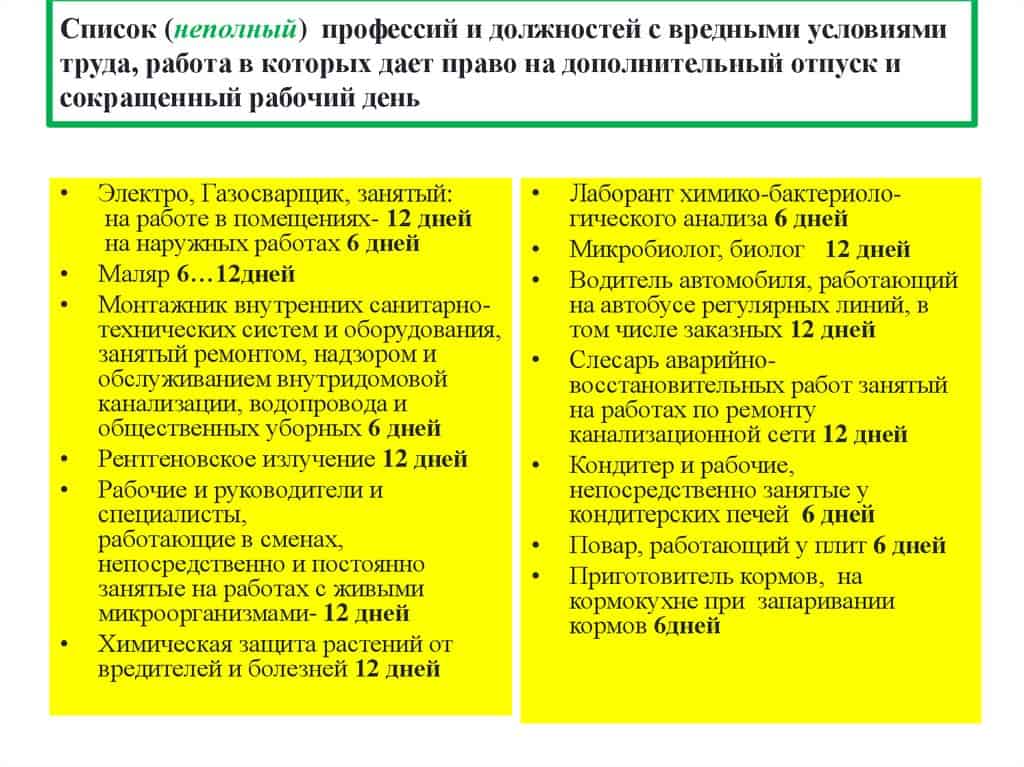
Professions with hazardous working conditions where additional leave is required
According to this list, there is a list of professions that are directly related to harmful ones. For example, a driver at a metallurgical plant will also qualify for early retirement if he has worked the required number of years. Teachers who teach the rules of handling chemicals and reagents are also included in the first list. The second list of hazardous occupations includes a smaller number of specialties.
List No. 2 of preferential professions
This list includes persons:
- processing metals and coal (welders, shop workers, rolled metal production);
- signalmen;
- employees of food factories;
- railway workers;
- social service workers;
- pharmaceutical production workers.
The specific list includes the following professions:
- electricians;
- geologists;
- agricultural machinery drivers;
- reinforcement workers, concrete workers;
- rolling stock drivers, conductors;
- workers installing communications equipment and maintaining stations;
- workshop for the production of metal pipes, chain-link mesh.
For your information! In order to avoid mistakes and correctly determine which category an employee belongs to, all professions are divided into lists. They are constantly adjusted according to the economic needs of the state.
Harmful professions for women
The influence of negative factors on the human body in the process of carrying out his professional activities is practically no different from the point of view of gender. However, there are some peculiarities in the fair half of humanity. The most harmful professions for women include the following:
- Teacher. This profession is characterized by a very large load on a person’s throat. Teachers very often suffer from sore throats due to the fact that they often have to raise their voices and experience constant stress;
- Surgeon. Due to the fact that the doctor has to spend almost all the time on his feet, there is a risk of varicose veins. Also often these specialists have problems with the back, spine, and so on;
- Hairdresser. Due to constant interaction with chemicals contained in paint, styling products, etc., a person may develop an allergy to the components of the drugs;
- Stewardess. Due to the constant change in pressure that occurs during takeoff and landing of airplanes, as well as vibration, tumors can form in the body of women, and due to low humidity levels, the skin often suffers;
- Sportswoman. Professional sports do not leave their mark on the human body. Constant stress often leads to menstrual dysfunction and sometimes to infertility.
Features of retirement conditions based on harmfulness
For an employee to be eligible for early retirement, several conditions must be met. Professions belonging to list No. 1 may stop working earlier provided:
- men aged 50, if their work experience has reached 20 years, of which 10 are in hazardous work;
- women aged 45 years, subject to a total work duration of 15 years, half of this period in dangerous work.
If you work in a hazardous industry, early retirement is possible if:
- men reach the age of 55 years, the total work experience must be 25 years, of which 12.5 years in hazardous production conditions;
- women over 50 years of age, with a total work history of 20 years, half in hazardous conditions.
If an employee has worked the required amount of time in a complex production, but the total length of service does not reach the required level, the employee can leave earlier in proportion to the number of years worked (not at 50, but at 53, for example, two years before the age pension).
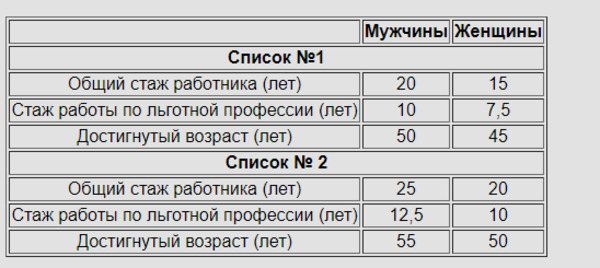
Conditions for early retirement for lists No. 1 and 2
List of professions with hazardous working conditions
- High dust content in the atmosphere. In particular, the work of the lungs is hampered when dust settles in them. Moreover, the higher the content of harmful substances in the dust, the more destruction such breathing brings to a person.
- Poor quality lighting. In conditions of insufficient or inappropriate lighting, the human psyche is most sensitive and susceptible to disorder, as well as the mood and physical condition of a person.
- Loud noises.
- Harmful radiation.
- Working with harmful objects such as viruses and microorganisms.
- Working with harmful chemicals.
- Vibrations, dirt.
- Increased humidity levels.
- High or low temperature.
- Difficulty, duration and intensity of work.
We recommend reading: What Documents Are Needed to Donate an Apartment to a Close Relative
Today, there is a Government Decree according to which people working in hazardous conditions have the right to receive certain benefits . The first list was approved more than 60 years ago and applies to those people who began their working career under the Soviet Union, the second list of hazardous professions is intended for people working in modern Russia.
Preferential pension provision according to lists No. 1 and 2
The procedure for calculating pensions is determined by Federal Law 400-FZ “On Insurance Pensions”. An employee will be accrued a preferential pension if the employer has made contributions to the state for all the years. There is no additional increase in the level of contributions. The size of the pension can be higher only taking into account the fact that wages in hazardous industries are higher compared to other areas.
Starting from 2015, the employer must pay an insurance payment of at least 9% of the employee’s income to the fund, otherwise the length of service will not be counted as work in hazardous working conditions. Due to changes in the retirement age, under the new legislation, persons who were previously supposed to retire in July 2021, and according to the new rules in January 2021, will be sent to retire six months earlier, that is, according to the old deadlines.
Thus, these lists play a significant role in the lives of many workers. They are important for arranging early retirement and related payments. They are no less interesting for the employer to know how to properly organize production activities.
List of harmful professions for early retirement
According to list No. 1, Resolution of the Council of Ministers of the RSFSR No. 517 of October 2, 1991, as amended by Resolutions of the USSR Cabinet of Ministers No. 591 of August 9, 1991 and No. 497 of July 23, 1991, established the right for early retirement for men when they turn 50 years old, subject to the accumulation of a specific work experience of 20 years or more. At the same time, you must work in hazardous industries for at least 10 years. The total pensionable work experience for women is fifteen years; they can claim a well-deserved rest at forty-five years. However, provided that they have worked in hazardous production for at least seven years.
List No. 1, which consists of 24 indicators, indicates industries with particularly harmful and particularly difficult working conditions, employment in which gives the right to an old-age pension on preferential terms.
This list includes work with radioactive substances, sources of ionizing radiation; ore preparation, including beneficiation, agglomeration (agglomeration, briquetting, pelletizing), roasting of ores and non-metallic minerals; mining; metallurgical and chemical, coke-chemical, metallurgical production. The first list also includes the production of explosives, initiating substances, gunpowder and ammunition equipment; processing of gas, oil, coal and shale; electrical production and repair of electrical equipment; production of electronic equipment and radio equipment.
The first preferential list includes the production of building materials, artificial and synthetic fibers; medicines, medical and biological preparations; printing, glass and porcelain-faience and pulp and paper production; nuclear energy and nuclear industry. Health care institutions, transport and the so-called general professions are listed separately;
The second list of 34 indicators of hazardous professions for early retirement, according to the Decree of the Government of the Russian Federation, includes specialists who were involved in the production of: gas, oil products, metal, glass, porcelain and earthenware, rocks. Workers in transport, printing and pulp and paper production, healthcare, electrical engineering, construction industry and other areas of human activity.

Production of artificial and synthetic fibers
Men will be able to exercise this right only upon reaching 55 years of age and having a total work experience of 25 years, taking into account the development of work experience in work with harmful working conditions of at least 12 years. According to the law, workers employed in industry, including mining, in the production and processing of metal, coal, and shale, may have this right. This right is also granted to certain categories of people who work in the field of communications, railway transport, and social security. The list of preferential professions also includes some creative ones. Many of us know that ballet dancers retire earlier.
If we succinctly define the list of hazardous professions for early retirement, summarizing all of the above, then 3 categories of workers can be classified as preferential working conditions:
- Those people who do physical hard work;
- Those people whose work poses a danger to life and health;
- Those people who work in unfavorable environmental conditions.
The last category usually includes participants in various expeditions, primarily: geological, prospecting and hydrological.
By the way, the recalculation of the retirement age is carried out according to certain rules, when one whole year of work for men is counted as 2 years, while for women it is counted as 2 years and four months.

